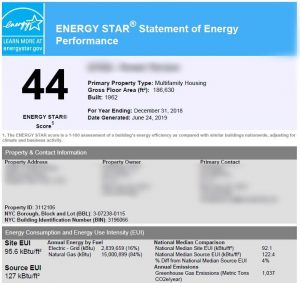The Case for Benchmarking

Kelly Dougherty, director of energy management, FS Energy
By Kelly Dougherty, director, energy management, FS Energy
Did you know that buildings in the United States account for 40% of total energy consumed? This equates to roughly $450 billion spent on energy bills each year. The greenhouse gas emissions associated with this energy use is approximately 40% of the nation’s total output.
One of the most cost-effective ways to decrease overall energy use is to improve the energy efficiency of buildings. New York City, home to more than one million buildings — which account for 70% of all emissions — recently introduced a comprehensive collection of carbon reduction laws designed to do just that.
The goal of its Climate Mobilization Act is to reduce carbon emissions by 80% by 2050
To achieve that goal, the city will begin imposing large fines to buildings that haven’t taken steps by 2025 to cut their emissions and meet their specified budgets. Starting in 2030 and every five years thereafter, emission limits/budgets will be lowered and hefty fines will be imposed on buildings that go over their annual carbon budgets.

NYC is home to 1 million buildings which account for 70% of all emissions
The Climate Mobilization Act did not come out of the blue — NYC has been setting the ground work for it over the past 12 years. And New York City is not alone. Toronto has also set a goal of reducing greenhouse gas emissions by 80% by 2050, having established its benchmarking law in 2017. This is a topic you will be hearing much more about with benchmarking laws popping up in every major city, as illustrated by this map.
What you don’t measure, you can’t manageThis is especially true when we talk about energy management. Knowing where your building stands relative to similar building types is an important first step. We do this through benchmarking, which is the process of gathering data on a building’s total energy consumption and comparing it to similar buildings. This provides decision makers some insight on how well or how poorly the building consumes energy. Buildings are grouped into similar types (residential, commercial, retail, school etc.), the data is normalized for weather and climate changes, and then compared to similar buildings using each building’s Energy Use Intensity per Square Ft (EUI = kBtu/Sq. Ft.).
Benefits of benchmarkingAn immediate benefit of benchmarking is that simply measuring and understanding a building’s energy use will help decision makers decide what the next steps need to be. Typically, benchmarking will trigger a more comprehensive look at the building through the process of conducting an energy audit and retro-commissioning study. In addition, in multi-family buildings, benchmarking helps to:
-
Reduce carbon emissions
-
Increase property values
-
Decrease operating costs
-
Improve marketability of buildings
-
Support wellness and quality of life for residents
Benchmarking, along with implementing energy efficiency strategies, helps buildings save money on an annual basis. Typically, these strategies will pay for themselves (depending on the measure) in two to 10 years. We encourage buildings to make regular energy efficiency upgrades and to plan for reducing energy consumption whenever a major piece of equipment needs to be replaced. It’s important to plan ahead as the opportunity may only come up once every 20 to 30 years (for major critical pieces of equipment such as boilers, chillers, etc.).
“When buildings are uniformly benchmarked—meaning their energy use is measured on a consistent basis—and when that information is shared publicly, the real estate market is empowered to consider the value of energy efficiency. Increasing the visibility of building performance in the marketplace will reward owners of efficient buildings and encourage more owners to invest in their buildings’ resource efficiency. Finally, the publicly available building data will be invaluable to policymakers, utilities and others as they design strategies and programs to serve their citizens, members and ratepayers more cost effectively.” – IMT Benefits of Benchmarking
Our moral obligation to assist and educate our stakeholders about energy issues
FS Energy, the energy management and advisory subsidiary of FirstService Residential, was established to help buildings reduce energy consumption, cost and emissions. We serve as advisors to boards, and managers providing data and support to drive informed decision making. As the largest residential management company in North America, we believe we have an obligation to assist and educate our stakeholders on their contributions to greenhouse gas emissions and help prepare them for legislative mandates around compliance and reduction. How do we do this?

Sample Statement of Energy Performance from ENERGY STAR
- Benchmarking: Complete compliance benchmarking in-house
- Report Cards: Provide annual reports to our clients that summarize their energy consumption to help engage in an annual energy conversation
- Education: Host an annual Sustainability Expo to educate clients on new and pending legislation and provide access to vendors and other resources
- Energy Advisory Services:
- Physically inspect buildings and provide energy assessments,
- Assist with capital planning, provide technology education,
- Deliver trainings on building sciences and energy efficiency to property staff and managers,
- Advocate on behalf of FirstService Residential clients to major city decisions around energy reduction
- Energy Procurement: Provide expert advice on energy purchasing strategies in deregulated states and provinces to drive down the cost of energy per unit

A common recommendation is to replace old fluorescent tube bulbs with LED bulbs to save energy and operating expense
Our goal at FirstService Residential and FS Energy is to provide guidance and support to our customers in order to help them make energy wise decisions and plan for the future of their investments.
Aside from the obvious environmental benefits of improving energy efficiency, investing in performance improvements of existing buildings will bring a boom to the economy, lower environmental costs from greenhouse gas emissions and decrease operating capital for building owners and tenants. It will also create job growth, supporting the development of a highly skilled energy-services labor market.



